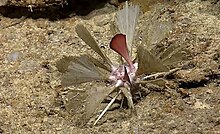
Sea urchins, are typically spiny, globular animals, echinoderms in the class Echinoidea. About 950 species live on the seabed, inhabiting all oceans and depth zones from the intertidal to 5,000 metres. Their hard shells (tests) are round and spiny, usually from 3 to 10 cm across. Sea urchins move slowly, crawling with their tube feet, and sometimes pushing themselves with their spines. They feed primarily on algae but also eat slow-moving or sessile animals. Their predators include sea otters, starfish, wolf eels, triggerfish, and humans.

Astropyga radiata, the red urchin, fire urchin, false fire urchin or blue-spotted urchin, is a species of sea urchin in the family Diadematidae. It is a large species with long spines and is found in the tropical Indo-Pacific region. It was first described in 1778 by the German naturalist Nathaniel Gottfried Leske.

Lytechinus variegatus, commonly called the green sea urchin or the variegated sea urchin, is a species of sea urchin that can be found in the warm waters of the western Atlantic Ocean and Caribbean Sea.
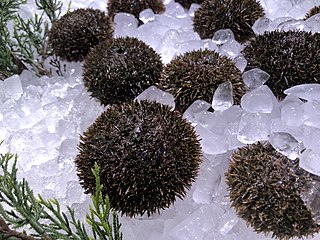
Hemicentrotus pulcherrimus is a species of sea urchin, the only one in the monotypic genus Hemicentrotus. It was first described by the American engineer and marine zoologist Alexander Agassiz in 1864 as Psammechinus pulcherrimus. Its range extends along the coasts of Korea and China, and in Japan from Kyūshū to Ishikari Bay. An edible species, it is harvested from Kyūshū to Fukui, in the Sea of Japan.

Echinus tylodes is a species of sea urchin in the Echinidae family. It is white with rather sparse pink spines, and is endemic to the eastern coast of North America including the Gulf of Mexico.

The Echinothurioida are an order of sea urchins in the class Echinoidea. Echinothurioids are distinguished from other sea urchins by the combination of a flexible test and hollow spines. The membrane around the mouth contains only simple plates, in contrast to the more complex mouth parts of their close relatives, the Diadematoida. They are nearly all deepsea dwellers.
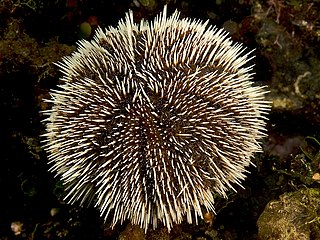
Tripneustes ventricosus, commonly called the West Indian sea egg or white sea urchin, is a species of sea urchin. It is common in the Caribbean Sea, the Bahamas and Florida and may be found at depths of less than 10 metres (33 ft).

Cidaridae is a family of sea urchins in the order Cidaroida.

Echinometra mathaei, the burrowing urchin, is a species of sea urchin in the family Echinometridae. It occurs in shallow waters in the Indo-Pacific region. The type locality is Mauritius.
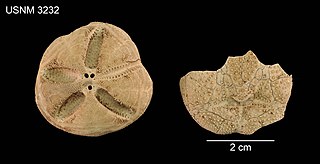
Abatus cordatus is a species of sea urchin in the family Schizasteridae. It is native to shallow seas surrounding certain island groups in the southern Indian Ocean. The body is protected by a hard test or shell which is covered with spines. The female broods its young in deep pockets on the upper surface, retaining the young in place with specialised spines. American zoologist Addison Emery Verrill first scientifically described A. cordatus in 1876.
Aspidodiadema jacobyi is a small sea urchin in the family Aspidodiadematidae. It lives in tropical seas at great depths. Aspidodiadema jacobyi was first scientifically described in 1880 by Alexander Emanuel Agassiz, an American scientist.

Echinometra viridis, the reef urchin, is a species of sea urchin in the family Echinometridae. It is found on reefs in very shallow parts of the western Atlantic Ocean and the Caribbean Sea.
Calveriosoma gracile is a species of sea urchin in the order Echinothurioida. It is a deep water species and is found on the seabed in western parts of the Pacific Ocean at depths of 200 to 800 metres.

Phormosoma placenta is a species of sea urchin in the order Echinothurioida. It is a deepwater species, seldom being found at depths less than 500 m (1,600 ft), and occurs on either side of the Atlantic Ocean on the continental slope.
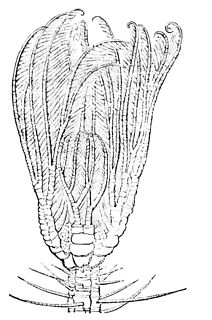
Cenocrinus is a monotypic genus of stalked crinoids in the family Isselicrinidae. The great West Indian sea lily is the only species in the genus and is found in deep waters in the Caribbean Sea and Gulf of Mexico.

Cidaris cidaris is a species of sea urchin commonly known as the long-spine slate pen sea urchin. It is found in deep water in the eastern Atlantic Ocean and the Mediterranean Sea.

Dermechinus is a genus of sea urchin in the family Echinidae found in deep water in the southern Indian, Pacific and Atlantic Oceans. It is monotypic, with Dermechinus horridus, sometimes called the cactus urchin, being the only species.
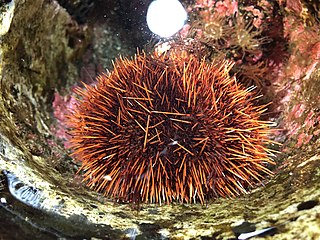
Pseudocentrotus depressus, commonly known as the pink sea urchin, is a species of sea urchin, one of only two species in the genus Pseudocentrotus. It was first described in 1864 by the American marine zoologist Alexander Agassiz as Toxocidaris depressus, having been collected during the North Pacific Exploring and Surveying Expedition undertaken by Captain Cadwalader Ringgold and later Captain John Rodgers.
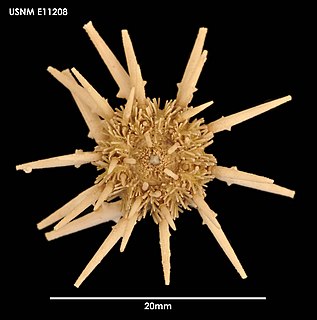
Goniocidaris umbraculum is a species of cidaroid sea urchin that inhabits the continental shelf off the southern coasts of New Zealand. It is plentiful on a seabed composed of seashell and bryozoan rubble at a depth of 95 m (310 ft) off Otago.

Pourtalesia miranda, commonly known as the wonderful sea urchin, is a species of sea urchin in the family Pourtalesiidae. It is found at abyssal depths in the Atlantic Ocean.
